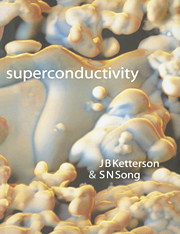Book contents
- Frontmatter
- Contents
- Preface
- Part I Phenomenologlcal theories of superconductivity
- 1 Introduction
- 2 The London–London equation
- 3 Pippard's equation
- 4 Thermodynamics of a Type I superconductor
- 5 The intermediate state
- 6 Surface energy between a normal and a superconducting metal
- 7 Quantized vorticity
- 8 Type II superconductivity
- 9 The Ginzburg–Landau theory
- 10 The upper critical field of a Type II superconductor
- 11 The anisotropic superconductor
- 12 Thin superconducting slabs
- 13 Surface superconductivity
- 14 The Type II superconductor for H just below Hc2
- 15 The Josephson effects
- 16 The Josephson lattice in ID
- 17 Vortex structure in layered superconductors
- 18 Granular superconductors: the Josephson lattice in 2D and 3D
- 19 Wave propagation in Josephson junctions, superlattices, and arrays
- 20 Flux pinning and flux motion
- 21 Time-dependent G–L theory
- 22 Fluctuation effects
- 23 G–L theory of an unconventional superfluid
- 24 Landau Fermi liquid theory
- Part II The microscopic theory of a uniform superconductor
- Part III Nonuniform superconductivity
- Appendix A Identical particles and spin: the occupation number representation
- Appendix B Some calculations involving the BCS wavefunction
- Appendix C The gap as a perturbation through third order
- Superconducting transition temperature, thermodynamic critical field, Debye temperature and specific heat coefficient for the elements
- References
- Additional reading
- List of mathematical and physical symbols
- Index
23 - G–L theory of an unconventional superfluid
Published online by Cambridge University Press: 05 June 2012
- Frontmatter
- Contents
- Preface
- Part I Phenomenologlcal theories of superconductivity
- 1 Introduction
- 2 The London–London equation
- 3 Pippard's equation
- 4 Thermodynamics of a Type I superconductor
- 5 The intermediate state
- 6 Surface energy between a normal and a superconducting metal
- 7 Quantized vorticity
- 8 Type II superconductivity
- 9 The Ginzburg–Landau theory
- 10 The upper critical field of a Type II superconductor
- 11 The anisotropic superconductor
- 12 Thin superconducting slabs
- 13 Surface superconductivity
- 14 The Type II superconductor for H just below Hc2
- 15 The Josephson effects
- 16 The Josephson lattice in ID
- 17 Vortex structure in layered superconductors
- 18 Granular superconductors: the Josephson lattice in 2D and 3D
- 19 Wave propagation in Josephson junctions, superlattices, and arrays
- 20 Flux pinning and flux motion
- 21 Time-dependent G–L theory
- 22 Fluctuation effects
- 23 G–L theory of an unconventional superfluid
- 24 Landau Fermi liquid theory
- Part II The microscopic theory of a uniform superconductor
- Part III Nonuniform superconductivity
- Appendix A Identical particles and spin: the occupation number representation
- Appendix B Some calculations involving the BCS wavefunction
- Appendix C The gap as a perturbation through third order
- Superconducting transition temperature, thermodynamic critical field, Debye temperature and specific heat coefficient for the elements
- References
- Additional reading
- List of mathematical and physical symbols
- Index
Summary
Although our discussion in this section will be largely phenomenological we must anticipate the major result of the microscopic theory which will be developed in Parts II and III; in particular we must make use of the fact that superfluidity in Fermi systems arises from the formation of a special kind of bound state in which electrons (or He quasiparticles) on (or near) the Fermi surface having oppositely directed momenta, + p and – p, form (collectively) bound pairs.
For the vast majority of superfluid electron systems (metals), the pairs form in a state with no net orbital angular momentum, an l = 0 or s-wave state which we will refer to as conventional fermion superfluidity; by the Pauli principle the electrons must then be in a singlet spin state (s = 0).
In the decade or so following the development of the BCS theory, and especially after the experimental discovery of the superfluid phases of liquid He, theorists explored various types of pairing in systems with a more complicated orbital and spin structure in which the gap can vary, in both magnitude and phase, with position on the Fermi surface. In the case of odd l pairing, the pairs form (again due to the Pauli principle) in a triplet s = 1 rather than a singlet spin state. The energy gap associated with such states may have zeros (i.e., vanish) at points or lines on the Fermi surface, and as a result the number of excitations at low temperatures varies as a power of the temperature, rather than exponentially.
- Type
- Chapter
- Information
- Superconductivity , pp. 152 - 179Publisher: Cambridge University PressPrint publication year: 1999



